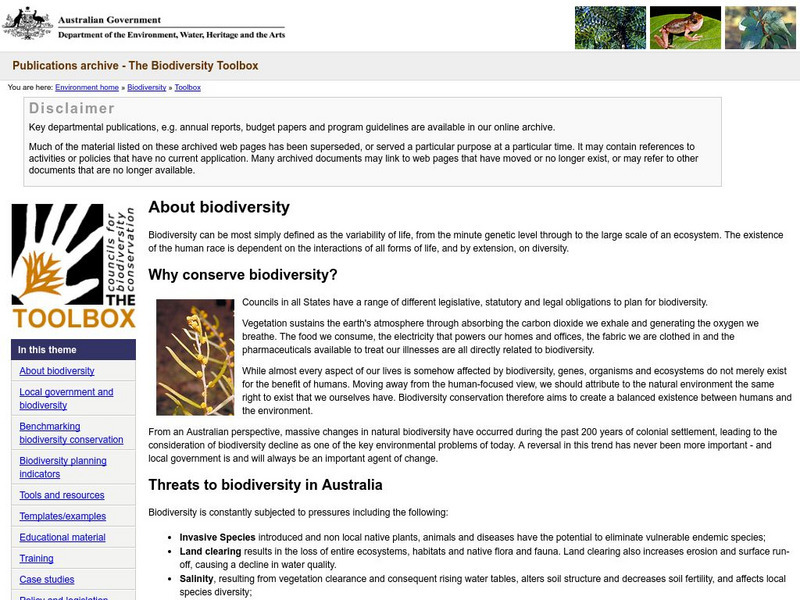Hi, what do you want to do?
Curated OER
Butterfly Life Cycle
Students identify the stages in the butterfly life cycle. After completing a KWL chart, students participate in a brief lecture on the stages of the butterfly life cycle. Using reading books and Internet research, students complete an...
Curated OER
A Changing Planet
Students describe climate change and the future impact it could have on our physical environment. They identify the regions of the world that would encounter the most significant effects of a global warming.
Curated OER
Habitat Lap Sit
Fourth graders physically form a circle that shows the interconnectedness of the components of a habitat. They form circles and role play the parts of habitats.
Curated OER
The Fish Trade
Students read and discuss a document regarding how the global fish trade is important to humans all over the world. Students conduct Internet research and write a scenario about what would happen if other countries did not help manage...
Curated OER
National Parks
Students create national park brochures on selected endangered animals using research information, hand-drawn pictures, and the Pages and KeyNote software programs. This lesson was written for a TAG classroom.
Curated OER
the Wonder of Wetlands
Young scholars explore the importance of the wetland ecosystem, its properties and functions, as well as, the many birds, animals, and plant life found there.
Curated OER
Lessons From the Lorax
Young scholars read and discuss Dr. Seuss's The Lorax. They explore the changes the characters could have made to preserve the environment and relate the plot to real-world places and events.
Curated OER
Charlotte's Web
Students examine the story, "Charlotte's Web" in the nine lessons of this unit. As the students progress through the book, they will explore the story plot, setting, character, and the value of friendship.
Curated OER
Wildlife, Wolves, Endangered Species
Students use the Internet to research wildlife and conservation efforts. They examine pictures and graphics to research endangered species and humans role in their lives. They also use math to measure areas of habitats and add the number...
Curated OER
The Web of Life
Students participate in a game in which they discover the balance of life in the ocean. They identify different organisms that rely on different types of food. They answer questions to complete the instructional activity.
Curated OER
Ani-mania
Learners view and discuss Robert Harris' farm landscapes and create their own mural out of wood. In groups, they discuss various issues affecting pets throughout the world and create a way to protest or celebrate the issue. They try to...
Curated OER
In Your Own Backyard
Students observe organisms in their habitat and record their observations. They then draw conclusions about the organism's habitat needs and food sources.
Curated OER
Geo-Exchange Box
Students send a box of clues to a class in another Oregon community along with hints to help them study about their community. Students research their own geographic area, determine what they send in their box, then collect and assemble...
Curated OER
Saving Hawaii
Students engage in a lesson about the a proposal for a sanctuary in the Northwestern Hawaiian Islands. They write a letter to the President of The United States in opposition to the proposal based upon classroom activities and research.
Curated OER
Gwynns Falls
Young scholars investigate the question: What is the impact of urban development and expansion on the health of a decidious forest ecosystem and humans? They examine the issue of land development by responding to a specific scenario and...
Alabama Learning Exchange
Alex: Animal Environment and Adaptation
In this lesson plan, students will enjoy different activities focusing on how animals adapt to their environments. They will begin by researching two animals, their environment, and the ways the animals adapt to this environment. In...
Louisiana Department of Education
Louisiana Doe: Louisiana Believes: Social Studies: Grade 3: A Log's Life
Third graders learn about the interdependence of animals and trees in nature and the cycles of growth and decay. Students also learn about the importance of preserving balance in nature and what happens when we upset that balance. While...
PBS
Pbs Kids: Plum Landing: Plum's Creature Connector
This PBS Kids activity is an extension of a Plum Landing episode featuring food webs. Students will learn basic information about how animals are interdependent. Students will help different animals survive in their different habitats
PBS
Pbs Teachers:cathedral in the Sea: Construct a Model Kelp Forest
Investigate the relationships among kelp forest inhabitants and their relationships to the giant kelp plant. List the parts of a giant kelp plant and construct a model of a kelp forest habitat.
Science Education Resource Center at Carleton College
Serc: Mn Step: The American Red Squirrel an Outdoor Inquiry Lesson
For this activity, students are presented with red pine cones that have been partly eaten by the American Red Squirrel, a fact that is not divulged to them at this stage. After a discussion of the possibilities, the class takes a walk in...
PBS
Pbs Teachers:a Model of Seed Dispersal
Investigate propagation systems in plants, and explain the ways some animals disperse seeds through their digestive processes. Role-play and map the daily travels of one seed-bearing animal to explore the migration of seeds.
TeachEngineering
Teach Engineering: Biodomes
Students explore the biosphere's environments and ecosystems, learning along the way about the plants, animals, resources and natural cycles of our planet. Over the course of lessons 2-6, students use their growing understanding of...
ArtsNow
Arts Now Learning: Using Tableau and Role Drama to Examine the Ecosystem [Pdf]
In this lesson, 4th graders use tableaux to dramatize their roles in the food chain of an ecosystem. Next, they write in role arguing why they are important to the ecosystem. This is followed by a debate in the format of a Character...
Other
Biodiversity Tool Box: About Biodiversity
An extensive site detailing Australia's committment to biodiversity conservation, including a list of threats and proposed plans of action as outlined in the "Environment Protection and Biodiversity Conservation Act of 1999."



























